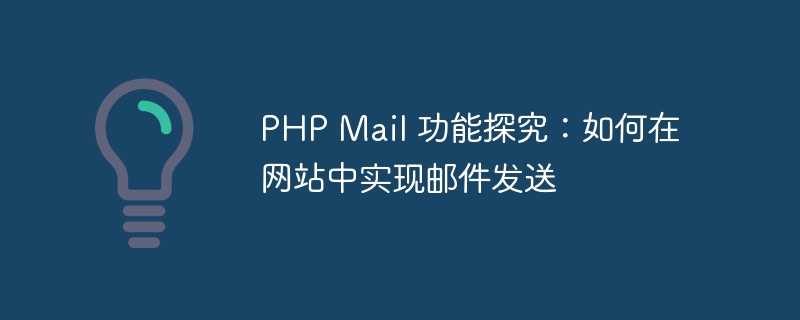

In the process of website development, the email sending function is one of the common and necessary functions. Using PHP's mail function, you can easily implement email sending operations. This article will discuss how to implement the email sending function in the website and provide specific code examples.
In PHP, you can use the mail function to send emails. The basic syntax of the mail function is as follows:
mail($to, $subject, $message, $headers);
Among them, the parameters are explained as follows:
$to: The address to receive the mail$subject: Email subject $message: Email content $headers: Optional parameters, used to specify email headers Information, such as sender, carbon copy, etc.First, make sure your server supports the mail function and the mail server has been configured. Next, we use a simple example to demonstrate how to implement the email sending function:
$to = "receiver@example.com";
$subject = "邮件主题";
$message = "这是一封测试邮件,您收到此邮件表示配置成功!";
$headers = "From: sender@example.com
";
if (mail($to, $subject, $message, $headers)) {
echo "邮件发送成功!";
} else {
echo "邮件发送失败!";
}In the above code, we specify the address to receive the email, the subject of the email, the content of the email, and the sender information. Send the email to the specified recipient by calling the mail function. Finally, it is judged whether the email is sent successfully and the corresponding prompt information is output.
In addition to simple text emails, we can also send emails in HTML format. For example, we can set the email content to HTML format and add styles, links, etc.:
$to = "receiver@example.com";
$subject = "HTML格式邮件";
$message = "<h1>这是一封HTML格式的邮件</h1><p>点击<a href='https://example.com'>这里</a>访问网站</p>";
$headers = "MIME-Version: 1.0
";
$headers .= "Content-type: text/html; charset=utf-8
";
$headers .= "From: sender@example.com
";
if (mail($to, $subject, $message, $headers)) {
echo "HTML格式邮件发送成功!";
} else {
echo "HTML格式邮件发送失败!";
}In the above code, we set Content-type to text/ html, specifies that the email content is in HTML format. HTML tags can be customized to present richer email content.
Sometimes we need to send emails with attachments, such as sending an email containing pictures or documents. Here is an example of sending an email with an attachment:
$to = "receiver@example.com";
$subject = "带附件的邮件";
$message = "这是一封带有附件的邮件,请查收!";
$filename = "attachment.pdf";
$file = file_get_contents($filename);
$attachment = chunk_split(base64_encode($file));
$headers = "MIME-Version: 1.0
";
$headers .= "Content-Type: multipart/mixed; boundary="boundary"
";
$headers .= "From: sender@example.com
";
$body = "--boundary
";
$body .= "Content-Type: text/html; charset=utf-8
";
$body .= "
$message
";
$body .= "--boundary
";
$body .= "Content-Type: application/pdf; name="$filename"
";
$body .= "Content-Transfer-Encoding: base64
";
$body .= "Content-Disposition: attachment; filename="$filename"
";
$body .= "
$attachment
";
$body .= "--boundary--";
if (mail($to, $subject, $body, $headers)) {
echo "带附件的邮件发送成功!";
} else {
echo "带附件的邮件发送失败!";
} In the above code, we support attachments by setting Content-Type to multipart/mixed. First send the text content of the email, and then add the attachment file as an attachment.
During the development process of the email sending function, you need to pay attention to the following security issues:
Through the introduction of this article, we have discussed how to implement the email sending function in the website and provided specific code examples. In actual development, the email sending function can be customized according to needs to provide website users with a better service experience. I hope this article is helpful to you, and happy development!
The above is the detailed content of PHP Mail function exploration: how to send emails on the website. For more information, please follow other related articles on the PHP Chinese website!




